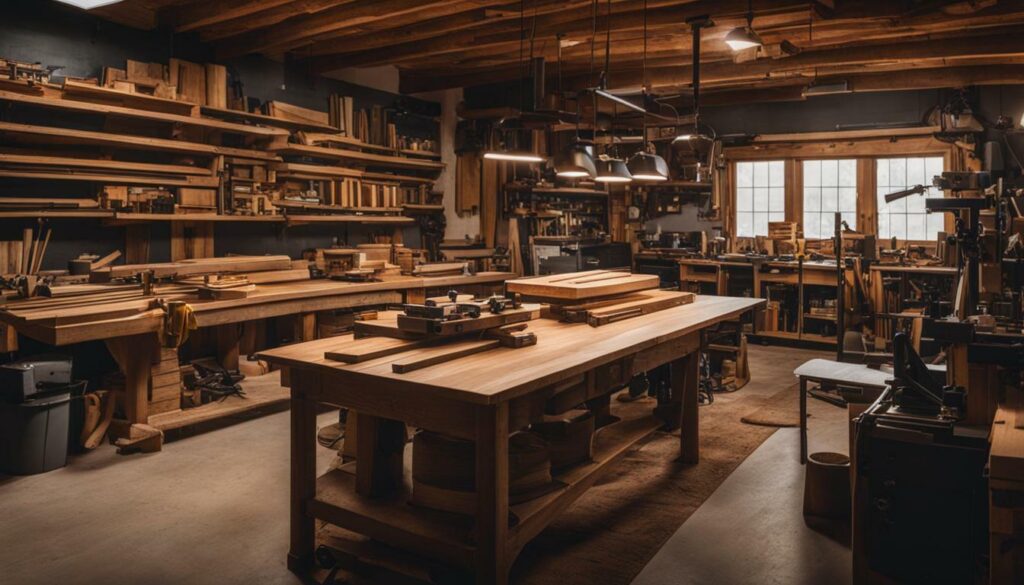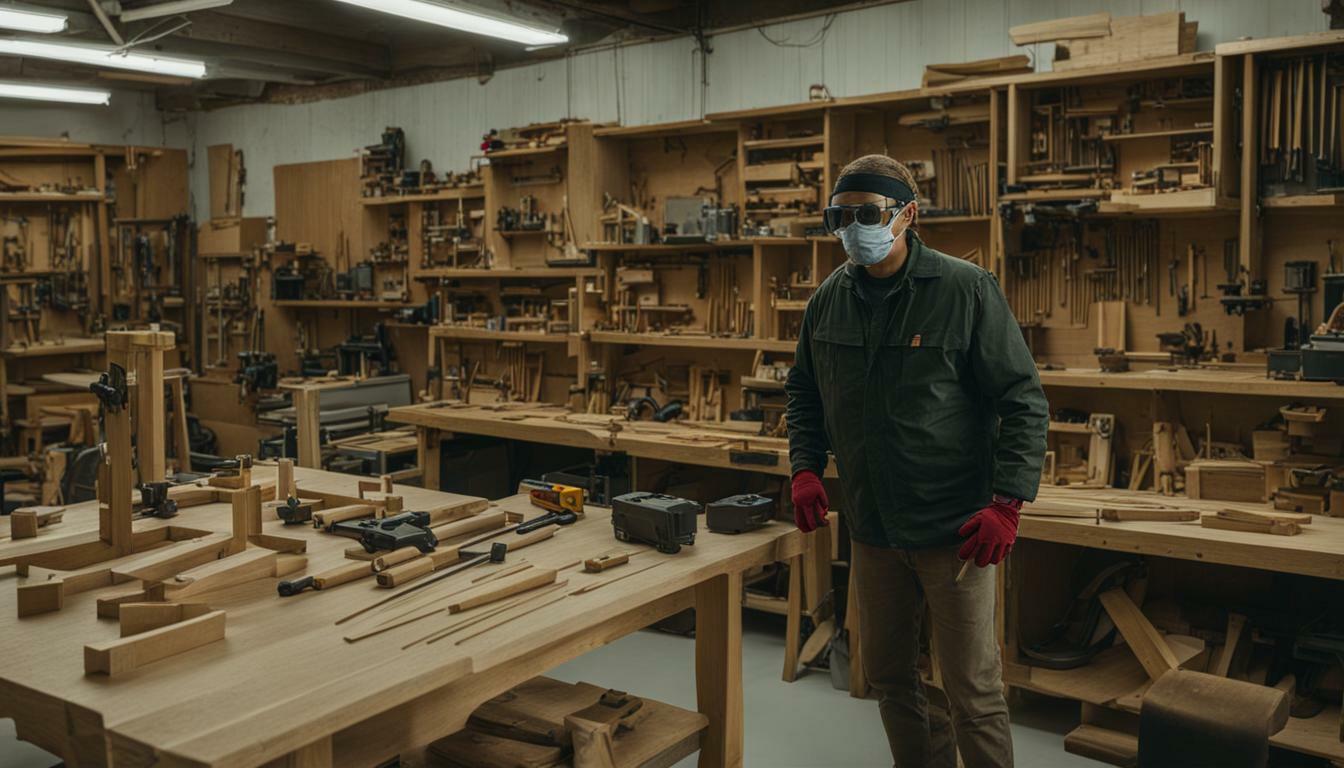Are you wondering if starting a woodworking business is a venture worth pursuing? Woodworking is not just a hobby; it can also be a profitable business opportunity. In this article, we will explore the key factors that can help you assess the value of starting a woodworking business and determine if it’s worth your time and investment.
Starting a woodworking business requires careful consideration of various aspects. Understanding the market potential and demand for custom woodworking services is essential. By identifying the niche market and analyzing its profitability, you can position your business for success.
Scalability and growth opportunities are also crucial when evaluating the worth of a woodworking business. Identifying avenues for expansion and exploring strategies to maximize profitability are important steps towards long-term success.
Quality craftsmanship and reputation play a significant role in the woodworking industry. Consistently delivering high-quality products and services can help establish your business as a trusted brand. Building a strong reputation will attract more customers and contribute to the overall value of your woodworking business.
Profitability analysis is essential in determining the worth of your woodworking business. By implementing cost-effective strategies and optimizing your operations, you can increase your profit margins and ensure long-term financial sustainability.
When considering buying an existing woodworking business, it is vital to ask the right questions. Understanding the reasons behind the sale, the involvement of family members, and the responsibility for sales can give you insights into the potential worth of the business.
Consulting with professionals and conducting thorough market research are invaluable steps in assessing the value of a woodworking business. Experts can provide guidance and advice based on their experience, while market research helps you understand customer preferences and potential competition.
Now, let’s summarize the key takeaways from this article:
Key Takeaways:
- Assessing the value of starting a woodworking business involves considering factors such as market potential, scalability, quality craftsmanship, and profitability analysis.
- Valuation methods, such as market-based, income-based, and asset-based approaches, can provide insights into the worth of a woodworking business.
- When buying an existing woodworking business, it’s important to ask questions about the owner’s motives, family involvement, responsibility for sales, and any major changes or financial performance.
- Consulting with professionals and conducting thorough market research can provide valuable insights into the potential success and profitability of a woodworking business.
Starting a woodworking business can be a rewarding venture. By carefully assessing its value based on market potential, scalability, quality craftsmanship, and profitability analysis, you can make an informed decision and embark on a successful journey in the woodworking industry.
The first step in evaluating the worth of starting a woodworking business is understanding the market potential and demand for custom woodworking services. This industry offers a multitude of opportunities for entrepreneurs looking to turn their passion for woodworking into a profitable venture. By providing unique, high-quality custom wood products, you can cater to a niche market that values craftsmanship and customization.

According to recent market research, the demand for custom woodworking services has been steadily increasing. More and more consumers are seeking one-of-a-kind furniture pieces, home decor items, and personalized gifts that reflect their individual style and taste. This presents a significant market opportunity for woodworking businesses that can deliver exceptional products tailored to their customers’ specific needs.
To tap into this market potential and ensure your woodworking business thrives, it is crucial to stay updated on the latest trends and designs, and to continuously innovate in your craft. By offering unique and customized woodworking solutions, you can set yourself apart from your competitors and attract a loyal customer base.
Table 1: Key Factors Influencing Market Potential and Demand for Custom Woodworking Services
| Factors | Influence |
|---|---|
| Consumer preference for unique and personalized products | High |
| Growing interest in sustainable and eco-friendly materials | Moderate |
| Increase in home renovations and interior design projects | High |
| Rise in demand for high-quality, durable furniture | High |
| Growing popularity of DIY and handmade products | Moderate |
By leveraging these market insights and meeting the demands of consumers looking for custom woodworking services, you can position your business for growth and success. Keep in mind that establishing a strong online presence through a well-designed website and effective marketing strategies can significantly boost your chances of capturing a larger market share and attracting a broader customer base.
Scalability and Growth Opportunities
Building a successful woodworking business involves considering the scalability and growth opportunities within the industry. As you establish your business, it’s important to assess the potential for expansion and development. This includes evaluating the demand for your products or services, exploring new markets, and staying updated on industry trends.
One key aspect of scalability is the ability to increase production capacity as your business grows. This may involve investing in advanced machinery, expanding your workspace, or hiring skilled craftsmen to meet the rising demand. By continuously adapting and expanding, you can capitalize on emerging opportunities and take your woodworking business to new heights.
| Scalability Strategies | Benefits |
|---|---|
| Investing in advanced machinery and technology | Increased productivity and efficiency |
| Expanding product range and diversifying offerings | Attracting a wider customer base and boosting revenue |
| Establishing strategic partnerships and collaborations | Access to new markets and distribution channels |
| Implementing effective marketing and branding strategies | Increased visibility and customer loyalty |
Moreover, growth opportunities can also arise from expanding into new markets or niches. Conducting market research and identifying untapped customer segments can help you tailor your products or services to meet specific needs. Additionally, exploring e-commerce platforms and online marketplaces can broaden your reach and attract customers from across the globe.
Remember, success in the woodworking business is not only determined by your craftmanship and products but also by your ability to adapt to changing market dynamics and seize growth opportunities. By continuously evaluating and pursuing scalability and growth, you can position your woodworking business for long-term success.

A critical aspect of determining the worth of a woodworking business is assessing the quality craftsmanship and reputation it can establish in the industry. In the world of woodworking, the skill and artistry of the craftsmen play a significant role in attracting customers and building a loyal client base. When your work reflects exceptional craftsmanship and attention to detail, it not only adds value to the pieces you create but also enhances your reputation as a skilled professional.
The woodworking industry values craftsmanship as a hallmark of excellence. By consistently producing high-quality products, you can differentiate yourself from competitors and position your business for success. Focus on honing your skills, from selecting the right materials to mastering intricate joinery techniques. This dedication to craftsmanship and the pursuit of perfection will set you apart and instill confidence in your customers.
Building a reputation in the industry is crucial for long-term success. Your reputation is a reflection of the quality of your work, your professionalism, and your commitment to customer satisfaction. Word-of-mouth recommendations and positive reviews from satisfied clients can significantly impact your business’s growth and profitability. Maintain strong relationships with your customers, deliver on your promises, and continuously strive to exceed expectations.
Providing Exceptional Customer Service
Another vital aspect of establishing a reputable woodworking business is providing exceptional customer service. Ensure that your clients feel valued and appreciated throughout their entire interaction with your business. This includes prompt communication, transparent pricing, and timely delivery of projects. Going the extra mile to accommodate special requests or offering personalized design options can also help elevate your customer service and leave a lasting impression on your clients.

Remember, your woodworking business’s success hinges not only on the quality of your craftsmanship but also on the reputation you build in the industry. By consistently delivering exceptional work and providing outstanding customer service, you can establish yourself as a trusted and respected woodworking professional.
| Key Takeaways: |
|---|
| Quality craftsmanship and reputation are crucial factors in assessing the worth of a woodworking business. |
| Focus on honing your skills and producing high-quality products to differentiate yourself from competitors. |
| Building a strong reputation in the industry through exceptional customer service and positive client experiences is paramount. |
Profitability Analysis and Cost-Effective Strategies
Analyzing profitability and implementing cost-effective strategies is crucial in determining the worth of a woodworking business. By carefully assessing the financial performance of your venture, you can make informed decisions that will maximize your profits and ensure long-term success.
To start, it is important to conduct a thorough profitability analysis. This involves examining your revenue streams, operating costs, and profit margins. By understanding where your money is coming from and how it is being spent, you can identify areas for improvement and implement strategies to increase your overall profitability.
One cost-effective strategy to consider is optimizing your supply chain. By carefully managing your inventory and sourcing materials at competitive prices, you can reduce your costs and increase your profit margins. Additionally, exploring alternative suppliers and negotiating favorable contracts can further enhance your bottom line.
| Profitability Analysis | Cost-Effective Strategies |
|---|---|
|
|
“By carefully assessing your financial performance and implementing cost-effective strategies, you can position your woodworking business for long-term profitability and success.”
Another strategy is to invest in technology and automation. By utilizing advanced tools and machinery, you can increase your production capacity, reduce labor costs, and improve efficiency. This not only enhances your profitability but also positions your business for scalability and growth.
Ultimately, the worth of your woodworking business depends on your ability to generate consistent profits and maximize your return on investment. By assessing your profitability and implementing cost-effective strategies, you can build a financially viable and sustainable venture.

Evaluating the worth of a woodworking business entails employing different valuation methods to obtain an accurate assessment. These methods include market-based, income-based, and asset-based approaches, each providing valuable insights into the business’s value.
The market-based approach involves comparing the woodworking business to similar businesses that have recently been sold. By analyzing comparable sales data, you can gauge the market demand for woodworking businesses and determine a fair value based on market trends.
The income-based approach focuses on the business’s potential to generate future profits. It involves analyzing the business’s financial statements, cash flow projections, and industry benchmarks to estimate its income-generating capacity. This approach is especially useful for evaluating established woodworking businesses with a consistent track record.
The asset-based approach considers the value of the business’s tangible and intangible assets. Tangible assets include equipment, machinery, inventory, and property, while intangible assets may include patents, trademarks, and customer contracts. By assessing the fair market value of these assets, you can estimate the overall worth of the woodworking business.

| Valuation Method | Pros | Cons |
|---|---|---|
| Market-Based | – Reflects current market trends – Utilizes real sales data – Provides a benchmark for negotiation |
– Limited availability of comparable sales data – Does not consider business-specific factors |
| Income-Based | – Considers the future earning potential – Evaluates the business’s financial performance – Incorporates industry benchmarks |
– Relies on accurate financial projections – Ignores business risks and uncertainties – Subjective assessment of growth prospects |
| Asset-Based | – Accounts for tangible and intangible assets – Provides a minimum value estimation – Useful for asset-heavy businesses |
– Ignores future earning potential – Difficult to assess intangible assets accurately – Challenging to determine fair market value |
It is essential to consider multiple valuation methods to gain a comprehensive understanding of a woodworking business’s worth. Depending on the specific circumstances and characteristics of the business, one method may be more appropriate than others. Consulting with professionals experienced in business valuations can further enhance the accuracy and reliability of the assessment.
Considerations When Buying an Existing Woodworking Business
Buying an existing woodworking business can be a viable option, but it’s important to consider various factors before finalizing the purchase. Assessing the worth of the business requires a thorough evaluation of its current state and future potential. Here are some key considerations to keep in mind:
Evaluating the Reason for Selling:
Understanding why the current owner is selling their woodworking business is crucial. It could be due to retirement, relocation, or other personal reasons. Knowing the motivation behind the sale can provide valuable insights into the business’s performance, market conditions, and potential risks.
Involvement of Family Members:
If family members are involved in the woodworking business, it’s essential to evaluate their level of commitment and expertise. Consider how their roles may impact the overall operation and future success of the business. Assess their skills and determine if they align with your vision and goals.
Responsibility for Sales:
Understanding the existing sales structure is vital. Evaluate the current customer base, sales channels, and marketing strategies. Determine if the business has a solid sales foundation and if you have the capacity to continue and improve upon these efforts.

Major Changes in the Business:
Examine if there have been any recent or upcoming changes that could impact the worth of the business. This could include new competition entering the market, changes in regulations, or shifts in consumer preferences. Assess the potential risks and opportunities associated with these changes.
Financial Performance:
Analyze the financial records of the woodworking business to understand its profitability, cash flow, and overall financial health. Evaluate revenue trends, expenses, and any outstanding debts. Consider seeking professional advice to ensure accurate financial evaluation.
By carefully considering these factors, you can make an informed decision when buying an existing woodworking business. Conduct thorough due diligence, seek expert advice, and envision how your skills and expertise can contribute to the growth and success of the business.
Consulting with Professionals and Market Research
To increase the chances of success in your woodworking business, it’s essential to seek guidance from professionals and gather market research. Consulting with experts who have experience in the woodworking industry can provide valuable insights and help you navigate potential challenges.
One key professional to consult is a business advisor or mentor who specializes in woodworking or small business management. They can offer guidance on various aspects, including business planning, pricing strategies, marketing techniques, and financial management. Their expertise can help you make informed decisions and avoid common pitfalls.
Market research is another critical component of assessing the value of your woodworking business. By understanding the current market trends, customer preferences, and competition, you can refine your offerings and identify unique selling propositions. Conducting surveys, analyzing online trends, and studying customer reviews can provide valuable data to inform your business strategies.
Benefits of Consulting with Professionals and Conducting Market Research
- Improved Decision Making: Consulting with professionals and conducting market research can provide you with valuable insights and data-driven information. This will help you make informed decisions that increase the likelihood of success in your woodworking business.
- Optimized Business Strategies: By seeking guidance from experts and staying updated with market trends, you can refine your business strategies to align with customer demands and stay ahead of the competition.
- Enhanced Brand Reputation: Professional advice and market research can help you establish a strong brand reputation. By delivering quality products and services that cater to customer needs, you can build trust and loyalty among your target audience.
- Identifying New Opportunities: Consulting professionals and conducting thorough market research can uncover untapped opportunities in the woodworking industry. This can help you diversify your offerings, expand your customer base, and increase profitability.
Remember, the woodworking industry is dynamic, and staying informed about market trends and industry best practices is essential for long-term success. By consulting with professionals and conducting market research, you can position your woodworking business for growth and profitability.

When assessing the value of an existing woodworking business, it’s important to ask the right questions to gauge its worth. By obtaining relevant information and insights, you can make an informed decision about acquiring or investing in the business. Here are some key questions to consider:
- Why is the owner selling the business? Understanding the owner’s motivation can provide valuable insights into the current state of the business and its potential for growth or challenges.
- What is the involvement of family members in the business? Family dynamics can have a significant impact on the operations and success of a woodworking business. Assessing the level of family involvement can help you understand how the business may be affected in the future.
- Who is responsible for sales and marketing? Effective sales and marketing strategies are crucial for the growth and profitability of any business. Knowing who is responsible for these key areas can help you evaluate the business’s ability to attract and retain customers.
- Have there been any major changes in the business recently? Understanding any significant changes, such as new product lines, expansion plans, or a shift in target market, can give you an indication of the business’s future potential.
- How has the business performed financially? Reviewing financial statements and performance metrics can provide insights into the business’s profitability, cash flow, and overall financial health. Look for consistent revenue growth, healthy profit margins, and a solid financial foundation.
Asking these questions and thoroughly evaluating the answers can help you determine whether the woodworking business is worth investing in. Remember to consider your own goals, skills, and resources in relation to the business’s potential for success. Consulting with professionals and conducting market research can further enhance your understanding and decision-making process.
Ultimately, acquiring an existing woodworking business can be a rewarding venture if it aligns with your passion for the craft and offers a viable opportunity for growth and profitability. By carefully assessing the right questions, you can make a well-informed decision that sets you up for success in the woodworking industry.

The involvement of family members and the division of responsibility for sales can significantly impact the worth and success of a woodworking business. When family members are actively involved, their unique skills and perspectives can contribute to the growth and overall quality of the business. However, it is important to establish clear roles and responsibilities to avoid conflicts and ensure effective collaboration.
Assigning specific sales responsibilities to different family members allows for a more targeted approach to generating revenue. One individual may focus on building and maintaining client relationships, while another manages online sales platforms or participates in trade shows. By dividing these tasks, you can maximize your reach and increase the chances of attracting customers.
Additionally, the involvement of family members in a woodworking business can foster a strong sense of pride, commitment, and dedication. Working together towards a shared goal not only strengthens family bonds but also enhances the overall work ethic and passion within the business.
It is crucial, however, to maintain open lines of communication and establish clear boundaries between business and personal relationships. Regular meetings to discuss business strategies, goals, and concerns can ensure that everyone is on the same page and working towards a common vision. By effectively managing family involvement and responsibility for sales, you can unlock the full potential of your woodworking business.

Major Changes in the Business and Financial Performance
Understanding major changes in a woodworking business and its financial performance is crucial in assessing its overall worth. As the industry evolves and market demands fluctuate, businesses must adapt and make strategic decisions to remain competitive and profitable.
One significant change to consider is the introduction of new technologies in woodworking. Advances in machinery and automation can streamline production processes, increase efficiency, and reduce labor costs. However, implementing these changes requires an initial investment and training for employees, which can impact the financial performance of the business in the short term.
Another important factor to evaluate is the impact of economic conditions on the woodworking industry. Economic downturns can affect consumer spending on luxury items and custom woodworking services. Businesses should closely monitor market trends and adjust their offerings accordingly to mitigate the potential negative effects on their financial performance.

Additionally, changes in consumer preferences and design trends can significantly influence the worth of a woodworking business. For example, if there is a shift towards sustainable and eco-friendly products, businesses that prioritize using environmentally friendly materials and implementing sustainable practices may attract more customers and gain a competitive edge.
Key considerations for assessing major changes:
- Monitor industry trends and technological advancements to identify potential opportunities for growth and improvement.
- Anticipate and prepare for economic fluctuations by implementing risk management strategies and diversifying revenue streams.
- Stay updated on changing consumer preferences and adapt business strategies to meet evolving demands.
- Regularly evaluate financial performance metrics and make necessary adjustments to optimize profitability.
In conclusion, understanding and evaluating major changes in the business and financial performance of a woodworking business are crucial for determining its overall worth. By staying informed, adapting to market conditions, and making strategic decisions, businesses can position themselves for long-term success and profitability.
| Factors to Consider | Impact on Worth |
|---|---|
| New technologies and automation | Potentially increased efficiency and reduced labor costs, but requires initial investment |
| Economic conditions | Potential impact on consumer spending. Mitigation strategies required. |
| Changing consumer preferences | Adaptation to trends and preferences can attract more customers and increase worth. |
Determining the Worth of a Woodworking Business
Assessing the worth of starting a woodworking business involves considering multiple factors to make an informed decision. One crucial aspect is the market potential and demand for custom woodworking services. Understanding the profitability and growth opportunities in this industry is key to evaluating the worth of your venture.
Quality craftsmanship and reputation play a significant role in establishing a successful woodworking business. The ability to deliver exceptional products and services and build a reputable brand can greatly impact the worth of your business.
An essential element in assessing worth is profitability analysis based on cost-effective strategies. Maximizing profits and running a business efficiently are vital for its long-term sustainability and financial success.
Moreover, valuation methods like market-based, income-based, and asset-based approaches offer valuable insights into the worth of a woodworking business. Understanding how these methods can help determine the financial value of your venture is crucial.
FAQ
Q: Is it worth starting a woodworking business?
A: Assessing the value of starting a woodworking business involves considering various factors such as market potential, scalability, quality craftsmanship, and profitability analysis. By evaluating these factors, you can determine if starting a woodworking business is worth it for you.
Q: What factors should I consider when starting a woodworking business?
A: Factors to consider when starting a woodworking business include market potential and demand for custom woodworking services, scalability and growth opportunities, quality craftsmanship and reputation in the industry, and profitability analysis based on cost-effective strategies.
Q: How can I determine the worth of a woodworking business?
A: Valuation methods including market-based, income-based, and asset-based approaches can be used to determine the worth of a woodworking business. Consulting with professionals and conducting thorough market research can provide valuable insights into the potential worth of the business.
Q: What should I consider when buying an existing woodworking business?
A: When buying an existing woodworking business, it’s important to ask questions about the owner’s reason for selling, the involvement of family members, responsibility for sales, major changes in the business, and financial performance. These factors can help you evaluate the worth and potential success of the business.
Q: Why is quality craftsmanship and reputation important in the woodworking industry?
A: Quality craftsmanship and reputation are crucial in the woodworking industry as they establish trust and credibility with customers. Building a strong reputation for high-quality work can lead to repeat business and positive word-of-mouth referrals, ultimately contributing to the success of your woodworking business.
Q: How can I maximize profitability in my woodworking business?
A: Analyzing profitability and implementing cost-effective strategies are essential for maximizing profits in a woodworking business. By identifying efficient production methods, minimizing waste, and optimizing pricing, you can improve your business’s profitability and financial performance.
Q: What are the benefits of consulting with professionals and conducting market research?
A: Consulting with professionals, such as business advisors or industry experts, can provide valuable guidance and insights into starting or expanding a woodworking business. Additionally, conducting thorough market research helps you understand your target audience, competition, and industry trends, enabling you to make informed business decisions.
Q: What questions should I ask when evaluating an existing woodworking business?
A: When evaluating an existing woodworking business, it’s important to ask questions about the involvement of family members, responsibility for sales, major changes in the business, financial performance, and the overall potential worth of the business. These questions can help you make an informed decision about purchasing or investing in the business.
Q: How does the involvement of family members affect a woodworking business?
A: The involvement of family members in a woodworking business can have both positive and negative impacts. While family members can provide support and contribute to the business’s success, it’s essential to establish clear roles and responsibilities to ensure smooth operations and minimize conflicts.
Q: What is the significance of financial performance in assessing the value of a woodworking business?
A: Financial performance is a crucial factor in assessing the value of a woodworking business. Examining revenue, expenses, profitability, and cash flow can help you determine the financial health and potential worth of the business, providing insights into its viability and success.
Q: What factors should I consider in determining the worth of a woodworking business?
A: The worth of a woodworking business depends on factors such as market potential and demand, scalability and growth opportunities, quality craftsmanship and reputation, profitability analysis, and financial performance. By considering these factors, you can gain a comprehensive understanding of the business’s worth and potential success.

